
Catherine of Alexandria is, according to tradition, a Christian saint and virgin, who was martyred in the early fourth century at the hands of the emperor Maxentius. According to her hagiography, she was both a princess and a noted scholar who became a Christian around the age of 14, converted hundreds of people to Christianity and was martyred around the age of eighteen. More than 1,100 years after Catherine's martyrdom, Joan of Arc identified her as one of the saints who appeared to and counselled her.

Rhenen is a municipality and a city in the central Netherlands. The municipality also includes the villages of Achterberg, Remmerden, Elst and Laareind. The town lies at a geographically interesting location, namely on the southernmost part of the chain of hills known as the Utrecht Hill Ridge, where this meets the river Rhine. Because of this Rhenen has a unique character with quite some elevation through town.

Willibrord was an Anglo-Saxon missionary and saint, known as the "Apostle to the Frisians" in the modern Netherlands. He became the first bishop of Utrecht and died at Echternach, Luxembourg.
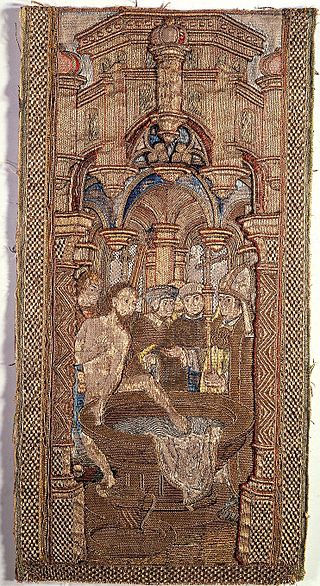
Redbad or Radbod was the king of Frisia from c. 680 until his death. He is often considered the last independent ruler of Frisia before Frankish domination. He defeated Charles Martel at Cologne. Eventually, Charles prevailed and compelled the Frisians to submit. Redbad died in 719, but for some years his successors struggled against the Frankish power.

Saint Ursula is a legendary Romano-British Christian saint who died on 21 October 383 or 385. Her feast day in the pre-1970 Calendarium Romanum Generale is 21 October. There is little information about her and the anonymous group of holy virgins who accompanied and, on an uncertain date, were killed along with her at Cologne. They remain in the Roman Martyrology, although their commemoration does not appear in the simplified General Roman Calendar of the 1970 Missale Romanum.

Dionotus was a legendary king of Cornwall in Geoffrey of Monmouth's Historia regum Britanniae, an account of the rulers of Britain based on ancient Welsh sources and disputed by many historians. Dionotus succeeding his brother Caradocus, and was regent of Britain during the campaigns in Gaul of Emperor Magnus Maximus. The curious thing about this king is that the Welsh chronicles, which parallel most of Geoffrey of Monmouth's book, do not mention this king by name. However, Geoffrey uses Latin versions of Welsh names so he could be referring to Dynod, duke of Cornwall, or Anwn Dynod, Maximus's own son.
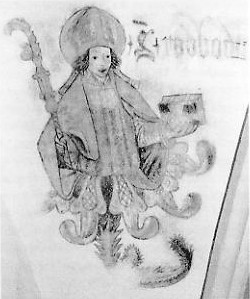
Saint Radbod was bishop of Utrecht from 899 to 917.
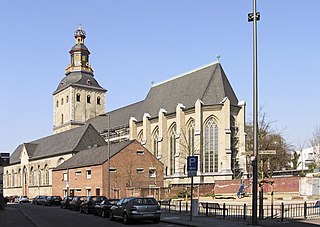
The Basilica church of St. Ursula is located in Cologne, North Rhine-Westphalia, Germany. It is built upon the ancient ruins of a Roman cemetery, where the 11,000 virgins associated with the legend of Saint Ursula are said to have been buried. The church has an impressive reliquary created from the bones of the former occupants of the cemetery. It is one of the twelve Romanesque churches of Cologne and was designated a Minor Basilica on 25 June 1920. While the nave and main tower are Romanesque, the choir has been rebuilt in the Gothic style.

June 11 - Eastern Orthodox Church calendar - June 13

July 17 - Eastern Orthodox Church calendar - July 19
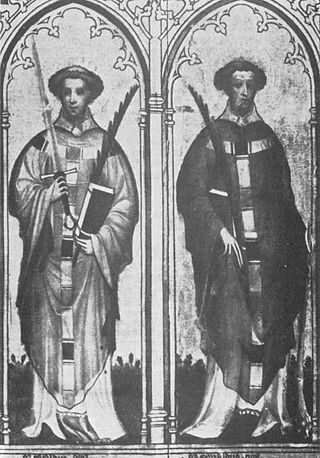
The Two Ewalds were Saint Ewald the Black and Saint Ewald the White, martyrs in Old Saxony about 692. Both bore the same name, but were distinguished by the difference in the colour of their hair and complexions. They began their mission labours about 690 at the ancient Saxons country, now part of Westphalia, and covered by the dioceses of Münster, Osnabrück, and Paderborn. They are honored as saints in Westphalia.
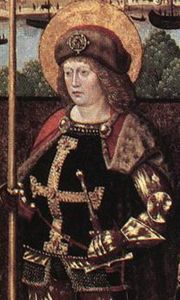
Saint Gereon of Cologne, who may have been a soldier, was martyred at Cologne by beheading, probably in the early 4th century.

The title Virgin is an honorific bestowed on female saints and blesseds in some Christian traditions, including the Eastern Orthodox Church and the Catholic Church.
Saint Conaire was an Irish holy woman who died in 530 AD. Originally from Bantry Bay in the south of Ireland, modern County Cork, she was an anchorite ; living in solitude in a self-imposed spiritual exile from society. Nearing the end of her life, she had a vision of all the monasteries in Ireland, and, extending from each upwards to the Heavens, was a pillar of fire.
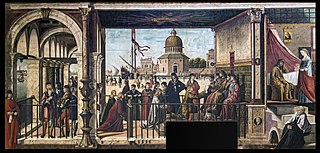
The Legend of Saint Ursula is a series of large wall-paintings on canvas by the Italian Renaissance artist Vittore Carpaccio, commissioned by the Loredan family and originally created for the Scuola di Sant'Orsola (Ursula) in Venice, which was under their patronage. They are now in the Gallerie dell'Accademia in Venice.

The Cunerakerk is the main church of Rhenen, Netherlands. During the Middle Ages it was an important pilgrimage site. The church has stored the relics of the Saint Cunera since the 8th century. The tower has a height of 81.8 metres (268 ft).
The coat of arms of Cologne may refer to the city's coat of arms or to that of the Elector and Archbishop of Cologne. The arms of the city have existed for some 1000 years and have changed several times during the history of Cologne. The first known arms are Per fesse dancetté Gules and Argent. Similar arms were used during the Napoleonic era.

Saint Odilia is a Saint venerated in the Roman Catholic Church, although according to the current liturgical calendar, her feast day is not officially commemorated. She is a patroness of good eyesight.
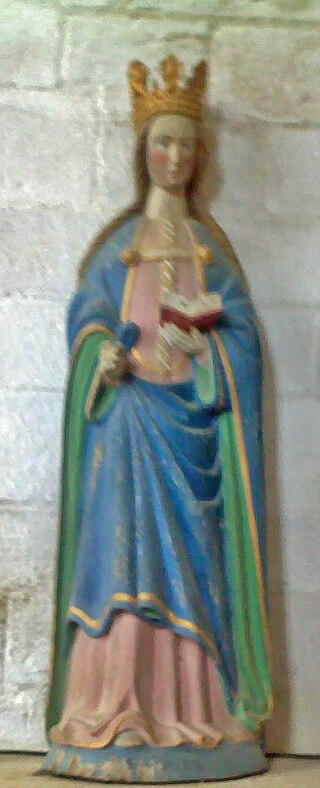
Saint Avoye of Sicily, also known as Saint Auré or Saint Ewe, was a Christian martyr from the 3rd century, who was originally from Sicily, Italy. She died in Boulogne-sur-Mer, France around 234, according to tradition. She is recognized as a saint in the Catholic Church.

A triptych of the Virgin and Child, with saints and an unidentified donor couple by the Master of Delft belongs to the Rijksmuseum but is on long-term loan to the Museum Catharijneconvent, Utrecht. It is dated to c. 1500–1510. The iconography of the central panel is unusual, and its meaning disputed.

















